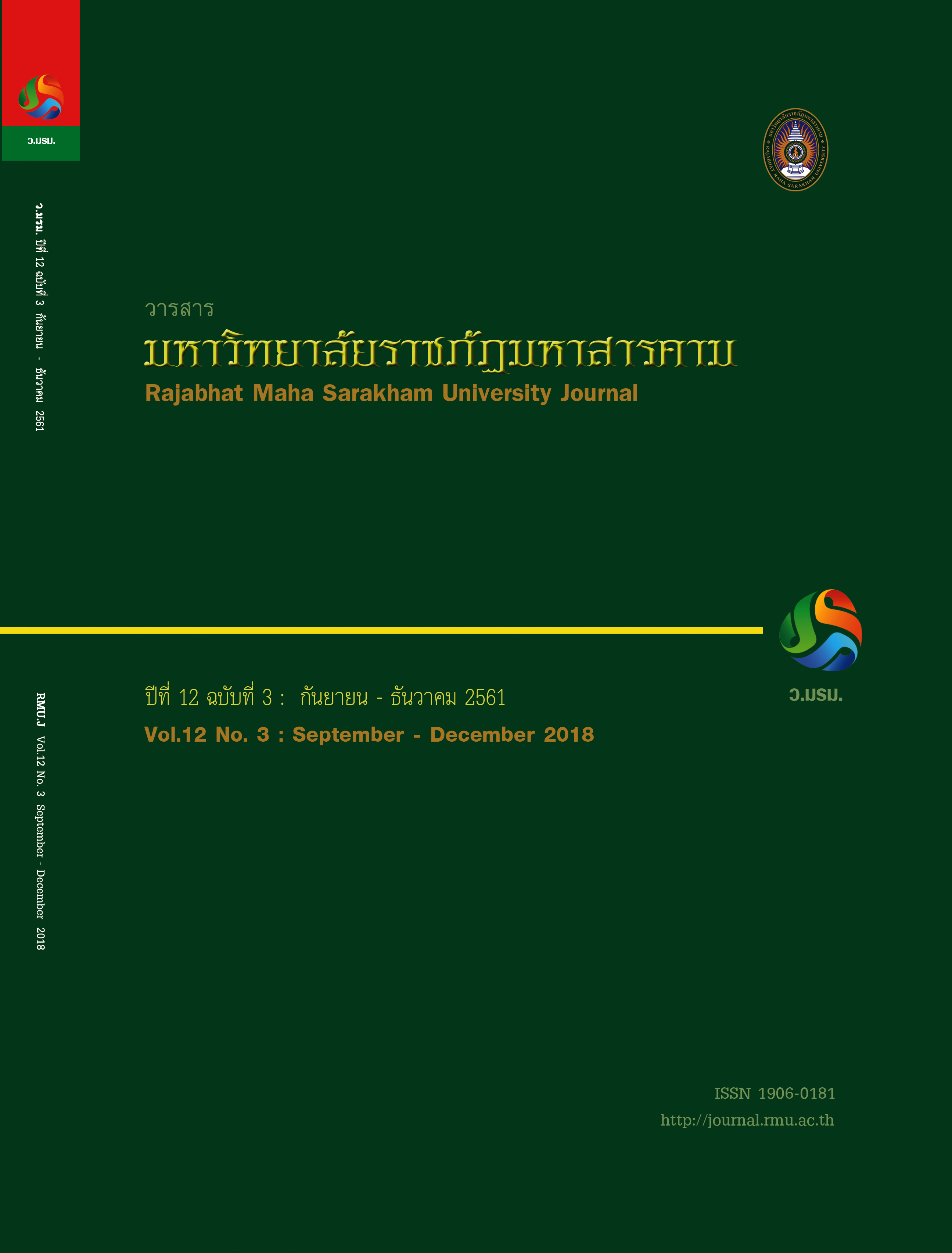การศึกษาตัวแทนความคิด เรื่อง พันธะเคมี ของนักเรียนชั้นมัธยมศึกษาปีที่ 4 ด้วยกิจกรรมการเรียนรู้ตามทฤษฎีคอนสตรัคติวิสต์
Main Article Content
บทคัดย่อ
การวิจัยครั้งนี้มีวัตถุประสงค์เพื่อศึกษาตัวแทนความคิด เรื่อง พันธะเคมี ของนักเรียนชั้นมัธยมศึกษาปีที่ 4หลังได้รับการจัดกิจกรรมการเรียนรู้ตามทฤษฎีคอนสตรัคติวิสต์ กลุ่มที่ศึกษาเป็นนักเรียนชั้นมัธยมศึกษาปีที่ 4โรงเรียนบรบือวิทยาคาร อำเภอบรบือ จังหวัดมหาสารคาม จำนวน 34 คน เครื่องมือที่ใช้ในงานวิจัยได้แก่ แผนการจัดการเรียนรู้ตามทฤษฎีคอนสตรัคติวิสต์ จำนวน 14 แผน รวม 20 ชั่วโมง แบบทดสอบวัดตัวแทนความคิดและแบบสัมภาษณ์กึ่งโครงสร้าง วิเคราะห์ข้อมูลโดยใช้สถิติพรรณนา ผลการวิจัยพบว่า นักเรียนสามารถแสดงออกความเข้าใจผ่านตัวแทนความคิดได้ในระดับที่ 5 หรือระดับการสะท้อนถึงการใช้รูปแบบของตัวแทนความคิด ได้แก่สมบัติและปฏิกิริยาของสารประกอบไอออนิกมีจำนวนร้อยละของนักเรียนสูงสุดรองลงมาคือ การเขียนสูตรและการเรียกชื่อสารประกอบไออนิก และพลังงานกับการเกิดสารประกอบไอออนิกมีจำนวนร้อยละของนักเรียนต่ำสุดนอกจากนี้ยังพบว่า การเกิดพันธะโคเวเลนต์ และความยาวและพลังงานพันธะ นักเรียนสามารถแสดงออกความเข้าใจผ่านตัวแทนความคิดได้ในระดับที่ 2
Article Details

อนุญาตภายใต้เงื่อนไข Creative Commons Attribution-NonCommercial-NoDerivatives 4.0 International License.
1. บทความที่ลงตีพิมพ์ทุกเรื่องได้รับการตรวจทางวิชาการโดยผู้ประเมินอิสระ ผู้ทรงคุณวุฒิ (Peer Review) สาขาที่เกี่ยวข้อง อย่างน้อย 3 ท่าน ในรูปแบบ Double blind review
2. ข้อคิดเห็นใด ๆ ของบทความที่ลงตีพิมพ์ในวารสารมหาวิทยาลัยราชภัฏมหาสารคาม นี้เป็นของผู้เขียน คณะผู้จัดทำวารสารไม่จำเป็นต้องเห็นด้วย
3. กองบรรณาธิการวารสารมหาวิทยาลัยราชภัฏมหาสารคาม ไม่สงวนสิทธิ์การคัดลอกแต่ให้อ้างอิงแสดงที่มา
เอกสารอ้างอิง
Office of the Education Council. (2017). Synopsis of the National Scheme of Education B.E. 2017–2036. Bangkok : Prikwan Graphic.
The Institute for the Promotion of Teaching Science and Technology. (2015). PISA Problem Soving Assessment. Journal of IPST Magazine. 43(191), 37-41.
Ministry of Education. (2008). The Basic Education Core Curriculum B.E. 2551 (A.D. 2008). Bangkok: Kurusapa Printing Ladphrao.
Boo, H. K. (1998). Students understanding of chemical bonds and the energetic of chemical reactions. Journal of Research in Science Teaching, 35, 569–581.
Gilbert, J. K., and Treagust, D. F. (2009). Multiple representation in Chemical Education. Models and Modeling in Science Education. Springer, 4(1), 333-350.
Treagust, D.F., Chittleborough, G., and Mamiala, T. L. (2007). The Role of Submicroscopic and Symbolic Representations in Chemical Explanation. Internationnal Journal of Science Education, 25, 1353-1368.
Kozma, R., and Ruaael, J. (1997). Multimedia and Understanding: Expert and Novice Responses to Different Representations of Chemical Phenomena. Journal of Research in Science Teaching, 43(9), 949-968.
Garnett, J. and Treagust, D. F. (1992). Conceptual Difficulties Experienced by Senior High School Students of Electrochemistry: Electric Circuits and Oxidation-Reduction Equation. Journal of Research in Science Teaching, 29, 121-142.
Chen, C. (2003). A Constructivist Approach to Teaching Implications in Teaching Computer Networking. Information technology Learning and Performance Journal, 21(2), 120-123.
George, E. H. (1991). Constructivist Learning Theory. CECA (International Committee of Museum Educators) Conference. Jerusalem Israel, 15-22.
Mvududu, N. H., and Burgess, J. T. (2012). Constructivism in Practice: The Case for English Language Learners. International Journal of Education, 4(3), 108-118.
Amineh, R. J., and Asl, H. D. (2015). Review of Constructivism and Social Constructivism. Journal of Social Sciences, Literature and Languages, 1(1), 9-16.
Cobb, P. (1994). Where is the Mind Constructivist and Sociocultural Perspective on Mathematical Development. Education Researcher, 23(7), 13-20.
Khammanee, T. (2015). Teaching Method. 19th ed.Bangkok: Chulalongkorn University Printing House.
Michalchik, V., Rosenquist, A., Komzma, R., Kreikemeier, P., and Schank, P. (2008). Representations Resources for Constructing Shared Understanding in the high School Chemistry Classroom. Theory and Practice in Science Education. Springer, 233-282.
Supasorn, S. (2012).Roles of Mental Models in Learning Chemistry at Molecular Level. Journal of Education Khon Kaen University, 35(1), 1-7.
Poonpipat, W. (2014). Effects of instruction based on the constructivist approach with multiple scientific representations of concepts on matter and properties and analyzing the ability of lower secondary school students. An Online Journal of Education, 9(1), 371-383.
Jenklang, R. (2015). The Development of Grade 12Students’ Representation Competence about Polymer Using Multiple Representation.National Graduate Research Conference, 34(1), 1658-1664.


